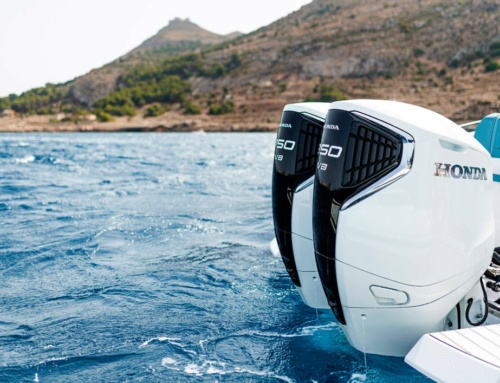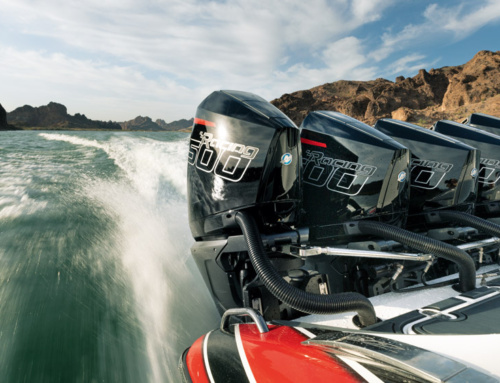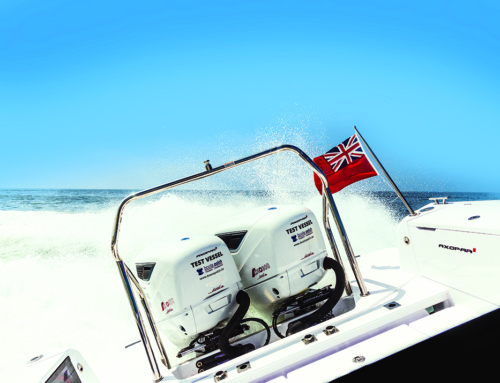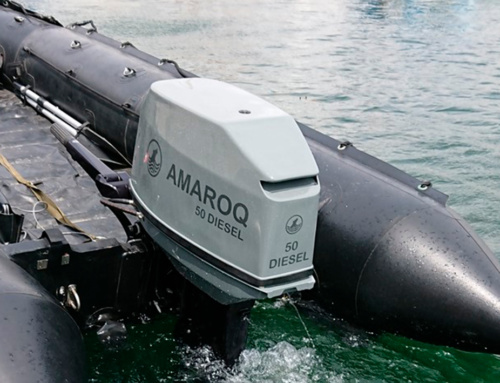- Servicing is made all the easier by a flushing connector on the front of the powerhead …
- In addition to an oversized gear case, which is claimed to be the most hydrodynamic Yamaha have designed, there are hardened gears and superstrength engine mounts.
- … the XTO 425 has the bonus of DFI up its sleeve, which, if Yamaha are true to form, will likely work a treat.
Yamaha XTO Offshore 425
Yamaha’s new 425hp 5.6L V8 XTO Offshore, which is due to hit our shores in the autumn, is an exciting event in outboard evolution, as Greg Copp explains …
Though it has roots in the still current F350, this engine is quite a different beast. It is the first 4-stroke outboard to use direct fuel injection (DFI). Why it has taken the marine industry so long to cotton on to technology that the automotive industry has been using to good effect for over a decade is anybody’s guess. Direct injection will yield efficiency gains of over 10% compared to conventional sequential fuel injection, as it has comfortably done with cars.
Sequential fuel injection injects petrol via an injector into each inlet manifold runner, allowing the atomised fuel/air mixture to enter the cylinder on the induction stroke as the inlet valve opens. In contrast, direct fuel injection injects directly into the cylinder head at the beginning of the induction stroke. Where direct injection wins over sequential is that injecting fuel into a very hot cylinder produces much more effective fuel/air atomisation. Consequently less fuel can produce more power. To achieve this, the XTO 425 uses an exceedingly high-pressure five-pump fuel delivery system that produces an injection pressure of up to 2900psi. Like the other big Yamahas, it also has variable inlet valve timing.
Most significantly, Yamaha’s DFI enables a high compression ratio to be used without risk of pre-ignition – in this case a ratio of 12.2:1, making it the highest compression ratio for any outboard. All petrol engines need to advance their ignition timing as RPM increases, as higher engine speeds mean less time for combustion. If you do not advance enough, power is lost and unburnt fuel passes through. If you overadvance, you get pre-ignition, where the piston is forcing its way up against a fully combusted fuel/air mixture. Otherwise known as ‘pinking’ or ‘knocking’, this is detrimental to power delivery and destroys pistons. High-compression-ratio engines normally require high-octane fuel in order not to pre-ignite, which is rarely available anymore. Most European petrol has an octane rating of 95, and other parts of the world less than that. However, an efficient fuel delivery system like direct injection combusts in less time due to better fuel atomisation, so it requires less ignition advance. Consequently this negates pre-ignition, while obtaining more power and torque from a higher compression ratio. The exhaust exits via an ‘in-bank’ exhaust system, providing a direct passage at high engine speed down through the lower leg and out of the propeller hub.
In torque terms, I have seen it reported that this engine produces 400ft/lb (546Nm) at 4200rpm. In normal outboard terms, this is well off the scale, and explains how the XTO can spin props from 16 to 171/8 inches in diameter. The engine has primarily been developed for the US fast fishing boat market, where this sort of power delivery is needed, but there will also be applications in this country to which it is suited, as it makes an effective alternative to a sterndrive petrol engine.
In addition to an oversized gear case, which is claimed to be the most hydrodynamic Yamaha have designed, there are hardened gears and superstrength engine mounts. The V8 XTO also features plasma fusion technology for the cylinder bores. This increases durability, while making for a more compact and lighter engine, due to the absence of iron cylinder liners. The micro-textured surface is 60 per cent harder than a conventional liner, and a lower surface friction also helps to marginally increase fuel economy. Dual overhead camshafts on each cylinder bank are connected via a self-tensioning chain, immersed in an oil bath, while carbon-coated valve lifters also increase durability, delivering quiet and precise valve timing.
There is an exhaust diverter system that redirects the flow of exhaust when in reverse, up to 2500rpm. This stops the exhaust from exiting via the hub, thereby improving the prop’s low-speed bite on the water when berthing. Yamaha claim this produces up to 300 per cent more thrust in reverse than the F350C. When you bear in mind that most XTO installations will be fitted with Yamaha’s fly-by-wire Helm Master system, having more reverse thrust will make outboard joystick berthing more effective.
Another industry first is a fully electronic steering system, rather than electro-hydraulic. This means superclean rigging with nothing more than electrical cables running from the helm to the engines. The actual electrical steering motor is a cylinder mounted on the front of the engine. It does add some weight to what is already a heavy motor, but on the flip side there is no on-board steering system.
Servicing is made all the easier by a flushing connector on the front of the powerhead, and a unique transmission oil drain facility that means the engine can be serviced on the water. This operates via a vacuum pump that connects to a drain port on the powerhead. All the engine cowlings can be removed, right down to the gearbox, though only the top cover has quick-release catches. For multi-engine fitments, the XTO requires 28.5 inches from centre to centre. As well as L, XL and XXL shaft lengths, Yamaha are offering the XTO with a 35in shaft, making it the first XXXL outboard engine. It is, of course, no lightweight, as in the long-shaft version it tips the scales at 432kg, but then in capacity terms it is not far short of a small-block sterndrive petrol engine.
This 60-degree V8 has a bore and stroke ratio of 96mm x 96mm, meaning it is built for a broad power spread, up to its maximum of 6000rpm. It relies on its 5559cc capacity and high compression ratio for torque. Yamaha claim it will run on 89 octane fuel, which is a necessity in the US, though they recommend higher-octane fuel when available. This does make you wonder about the viability of high-compression engines in an environment where fuel quality is questionable – like outside western Europe. All modern petrol engines have a ‘knock’ sensor, which will tell the ECU to retard the ignition if it detects pre-ignition, but power and efficiency inevitably suffer slightly as a result. I suspect that Suzuki’s lower-compression DF325 launched on the back of the high-compression DF350 was a safeguard option for those operating in low-octane fuel areas. However, the XTO 425 has the bonus of DFI up its sleeve, which, if Yamaha are true to form, will likely work a treat.
The European launch will be at the Genoa Boat Show in September.
Contact
www.yamaha-motor.eu/uk













